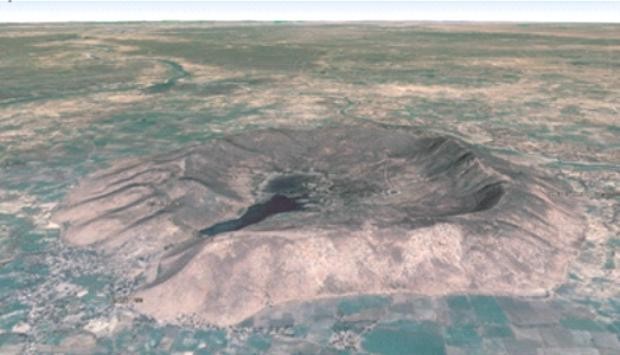
Millions of years ago, this Rajasthan village was hit by an asteroid, geologists confirm
- Select a language for the TTS:
- UK English Female
- UK English Male
- US English Female
- US English Male
- Australian Female
- Australian Male
- Language selected: (auto detect) - EN
Play all audios:

A much studied crater in the sleepy village of Ramgarh in Rajasthan has finally been confirmed as an asteroid impact spot by two separate international teams of geologists1,2. The exact size
of the crater is still a matter of debate though.
This makes the Ramgarh crater, studied for more than five decades for its spectacular geomorphic features, the third impact structure in India. The now eroded crater in the Vindhyan
Supergroup of sedimentary rocks dates back to the Mesoproterozoic age (roughly 1600 to 1000 million years ago).
The scientists, including a group from the Physical Research Laboratory (PRL) in Ahmedabad, analysed the chemical composition of the rocks at the impact site to conclude that the crater was
created by the impact of a "copper-rich iron meteorite." A meteorite is a fragment of an asteroid.
The mineralogical and geochemical characteristics of the millimetre-sized, iron-rich spherule-like particles, which they recovered from the alluvium inside the crater, also bore signatures
of a meteorite impact. The absence of any known volcanic structure nearby strengthens the theory of an impact, according to their report1.
The mm-sized magnetic particles, which the scientists recovered from the rim of the Ramgarh structure shows presence of coesite, a high pressure polymorph of silicon dioxide, “one of the
most diagnostic indicators of impact origin," says Dwijesh Ray of PRL and lead author of one of the studies.
"The presence of a possible central peak and its current crater diameter/depth ratio of ~12 well corroborate the range of terrestrial complex asteroid impact craters,” Ray told Nature India.
Earlier, Thomas Kenkmann with colleagues Gerwin Wulf at the University of Freiburg in Germany, and Amar Agarwal from the Indian Institute of Technology Kanpur also documented the “planar
deformation features, planar fractures, and feather features” in quartz grains from the centre of the Ramgarh structure, to confirm its origins in an asteroid impact2.
Roughly rectangular in shape, the Ramgarh crater resembles the well-known Barringer Crater in the US. Worldwide, 204 impact craters have been reported, of which two are in India: the Lonar
Crater in (Maharashtra) in the Deccan Traps, and the Dhala Structure in Bundelkhand (Madhya Pradesh). The Ramgarh structure was first discovered by the Geological Survey of India in 1869.
The Geological Society of London identified it as a ‘crater’ in 1960.
Impact cratering is a geological process that shapes the surfaces of the terrestrial planets when high velocity asteroids or comets hit them. Imprints of past impacts on the Earth are poorly
preserved because of the continued action of mountain building due to plate tectonics, weathering and erosion. Therefore, identifying new asteroid impact structures on Earth is challenging
for palaeontologists.
"Many researchers have attempted to establish its impact origin and only recently concrete evidence has emerged in the form of documentation of shock metamorphosed minerals in the target
rocks of Ramgarh structure," says Senthil Kumar, principal scientist at the National Geophysical Research Institute in Hyderabad.
Kumar says this requires further investigation since both these studies differ in their estimation of the size of the Ramgarh crater. While Kenkmann and colleagues consider the Ramgarh
structure to be a large complex crater of 10-km diameter, Ray and team have described it as a crater with a rim-to-rim diameter of 2.4 km.
Ray concedes that the precise diameter of Ramgarh structure is still a matter of debate. “While Kenkmann et al. estimated the diameter based on the remote sensing survey, we hope there is
still scope to find the exact size of the impact structure through field based survey using geophysical techniques,” he says.
Kenkmann explains that the PRL study took the topographically apparent ring-like structure of the Ramgarh crater and interpreted it as the uplifted crater rim. “We demonstrate that the
topographic ring (collar) is the remnant of a central uplift, which is a typical feature of larger craters that make up more than 60 per cent of craters on Earth,” he adds.
1. Ray, D. et al. Iron-nickel metallic components bearing silicate-melts and coesite from Ramgarh impact structure, west-central India: Possible identification of the impactor. J Earth
System Sci. (2020) doi: 10.1007/s12040-020-1371-7
2. Kenkmann, T. et al. Ramgarh, Rajasthan, India: A 10 km diameter complex impact structure. Meteorit. Planet. Sci. 1-26 (2020) doi: 10.1111/maps.13454
